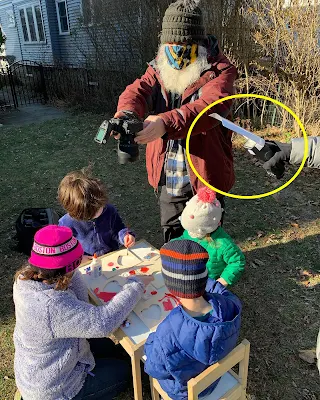My first shooting gig in Boston was a cool venture called
Backyartists, a company started by two experienced early childhood educators. Backyartists mostly caters to local families with pre-school aged children, but they also ship out seasonal and holiday boxes of open-ended process art and sensory activities for kids ages 3-9. Today I was taking marketing shots of their Friendship & Love box, for Valentine’s Day.
My goal was to create images they couldn't easily make with their smartphones. I used an f/2.8 lens shooting wide open so the background would be beautifully de-focused, and had their backs to the sun so that their hair (or hats in this case) were illuminated, giving them a certain glow. Wireless flash (with my usual paper diffuser) was used to illuminate the faces, completing the look. If I do a good job, you won't even notice that I used a flash, although you might subconsciously pick up that there was something special about the pictures. (Click on any image to view larger and sharper.)
 |
| The Founders |
 |
| Here's a BTS shot. The yellow circle shows the wireless flash, held off to the side. |
I shot minimalistically (that's a word!) - A7R IV and a small Godox flash and a paper flash diffuser. Being small, the flash didn't always recycle in time and so I ended up with some shots that were darker than I'd like. Can I fix it by lightening the parts that the flash would have illuminated,
like I did way back in 2015?
So in this instance I could have dispensed with the expensive flash and just spent more time in front of my computer (AAUUUGGGHHH!!). But this is a mild case. Is it universally true? After all, you can do some pretty dramatic stuff with wireless flash!
 |
| (It can improve indoor pics, too!) |
So let's have a contest. Below is a set of before and after images taken from
my blog post of 2015, which talked about lighting for environmental portraits.
 |
| This is what good light can do. What do you think of him now? |
Can you take the first picture above and turn it into the 2nd picture using the post-processing tool of your choice? Links to the raw files are
here. Send your best efforts to info at Friedman Archives dot com . The winner will receive both fame and glory in next month's blog. :-) Let's see if wireless flash still has a place in the smartphone era.
A7S III Obscurities
 |
| Sony A7S III, ISO 12,800 1/100th f/2.8 in a ridiculously dark room. |
The book on the A7S III is taking forever because pretty much everything has either been moved around or completely re-implemented with new options and new names. And the menus change depending upon the position of the exposure mode dial. I don't mean that certain items get greyed out like before, I mean the menu items just vanish, and the remaining items get renumbered. (See example below.) Great if you're worried about too much clutter in your menus; unfortunate if you're writing a book about the camera and you want to have a short-hand notation for menu items.
 |
| Menu items appear and disappear (and menu pages
renumbered!) when the exposure mode dial goes from P/A/S/M to Movie mode. Notice Menu 5 in P/A/S/M mode (left) is
different from Menu 5 in Movie mode (right). |
Another thing I'm learning is that nothing on God's green earth can open the .HIF files produced by this camera. HIEF is a new High Efficiency Image Format that may one day
become as ubiquitous as .jpg. It can
represent still images at half the size of .jpgs, uses 10 bits per channel
instead of 8 bits (allowing it to hold a higher dynamic range), and can also
accommodate audio, video, and store more information than conventional EXIF
data fields. Originally standardized in
2015 and officially embraced by Apple in 2017, HEIF (or specifically .HEIC
files as output by iOS devices) is becoming the defacto standard for smartphone
images not only for its small file size but also for its ability to store
distance information from newer smartphones that have time-of-flight sensors. Smartphones can use
this information to provide progressive levels of Gaussian Blur to areas of an
image further away, allowing them to take pictures that look like they were
taken by an expensive f/2.8 telephoto.
The problem with the .HIF file (as produced by the A7S III) is that nothing can open them.
Not Photoshop; not Sony’s Imaging Edge Desktop suite, not Windows 10
with HEIF codecs installed,
and not even Mac computers (even when the extension was renamed to .HEIC – only
the thumbnail was recoverable). Sony
DOES provide free software conversion tool which converts .HIF files to
either .JPG or .TIF, though, making the format just somewhat useful. This program only works on images shot
on an A7S III and not on other cameras (such as an iphone).
Of course I don't mean to sound negative. How wonderful it is to have this legendary low-light camera with phase-detect AF built-in! It's the professional video camera in a tiny package; and has been called the affordable FX-6. Professional videographers are flocking to it. And you can pre-order my book on it at a discount here.
Streaming Seminar On Sale
The worst of the pandemic will probably be over in a few months when the vaccines roll out, so why not make good use of your remaining isolation time and learn the secrets to "Wow!" photography that would make you an Instagram star?
The streaming version of
The Friedman Archives Seminars are on sale for the next 30 days! Take advantage of my world-famous technique for explaining complex things in an understandable way, and showing you hot to take images that make you say "Wow!" without spending your life learning Photoshop. Use discount code
secretsrevealed during checkout to get your discount!
Next time in Cameracraft Magazine
The March/April issue out March 1st
- Pete Woods' world of insects and birds.
- Natasha Ince's amazing maternity portraits.
- See how a wedding professional has made drone aerials a key to success.
- Find out how the Zeiss Batis 40mm f/2, Sigma i-Series 65mm f/2 and Tamron 17-70mm f/2.8 lenses perform.
- Sony A1 unveiled,
- photobook making with double-sided Permajet paper,
- and all our regular writers. Even Gary's quarantine beard's multiple personalities...
Cameracraft is among the last of the great printed photo magazines.
Subscribe now and see what you've been missing!
In the Pipeline
The book on the A7R IV is almost finished being translated into Spanish. Envíeme un correo electrónico a Gary at Friedman Archives punto com si desea ser notificado.
And of course, The Sony A1 is out. If I get enough email requests I'll write a book on it. Send your requests to Gary at Friedman Archives dot com.
Zoom Talks for your Photo Club
Over the past 9 months I've given Zoom lectures to about 35 photo clubs the world over, which has been one of the few highlights for me during this pandemic, since I love teaching and talking with other photographers. I can do this for your photo club as well! Contact me to discuss details.
Until next time,
Yours Truly, Gary Friedman
 |
| Better not pout! |
























Hi Gary, can you elaborate on the placement and the equipment, other than the flash, used for the marketing pictures in this article, please?
ReplyDeleteWell, other than the flash there's only one other piece of equipment (the camera), So I'm not sure what you're asking. Please email me privately with a clarification.
DeleteYes on the A-1 book please.
ReplyDeleteUnderstand your frustration with the new menus, but at least this exercise will lessen your labor when writing the next book about Sony A1!
ReplyDeleteGary,
ReplyDeleteThe lead-in email said something about do we still need wireless flash. You didn't follow up on that, but I was going to say I still need wireless flash because the older Sony contacts on my a77 do not work and never have. I hope the new design - the more standard kind of contacts, right - do work, but until then wireless is the more reliable.
On the books, it would be really interesting to read one on how you go about writing a manual for a new camera. Do you have a standard set of procedures that you go through that we could all use when we get a new camera to run it through its paces and learn it well? They get so complicated, I can't remember how to set white balance manually any more. "Friedman's Manual Manual."
Other Gary
Didn't follow up on it??? Did you read the blog post? :-)
DeleteI do have a process I follow when writing the books, but I kept it to myself up until now because 1) I don't have any time to produce it, and 2) I can't fathom it would be of interest to anyone (except a potential competitor). I'll consider it for the future, though.
The blog post was about the advantages of fill flash but didn't address in particular why that should be wireless. I also wanted to communicate my dissatisfaction with the Sony flash contacts. The Sony F42 "wireless" flash works only with the pop-up flash, and doesn't even have a PC sync cord option! I had to get a specialty camera bracket that could hold the camera and the flash separately while permitting me to raise the pop-up flash to make it all work.
ReplyDeleteI was hoping you would get more into the tech details of why wireless flash and how to do it. I also thought you were implying that they would be discontinuing wireless flash in the future - which would be tragic!
Oh. Sorry if you felt misled. The topic was "since you can lighten things up in post, that look reasonably close to what an off-camera fill flash could do, is fill-flash now obsolete?" Next month we'll see submissions from the contest to know for sure. :-)
DeleteThe F42 flash is a relatively older model; and like most of the older models, lack a PC sync connector.
I personally am a fan of the old Minolta-designed hot shoe that Sony inherited (see blog post at https://friedmanarchives.blogspot.com/2012/12/the-taming-of-shoe.html ); and actually dislike Sony's MiS design (see other blog post at https://friedmanarchives.blogspot.com/2016/01/possible-solutions-to-hot-shoe-design.html )
Finally, have you considered the Sony ADPAMA adapter to allow your F42 flash to sit atop your hot shoe?
A book on the A1 would be appreciated!
ReplyDeleteBuying an A1. Would love to say a GF book on it
ReplyDeleteI don't do people pictures.
ReplyDeleteI use wireless flash for macro, right up to x10.
Higher ISO can be used for some low magnification shots in dim light.
I use the Olympus m4/3 R system with my EM-1. I use at least two units. One capable of acting a master can be mounted on the hot shoe but I prefer to place it on an L-bracket. Control is then via a small unit, set to give the necessary pre-flash but not a contributing flash. The second unit may be free-standing when working at ground level. Only Olympus provide ones which tilt downwards at 45 degrees.
The best* I could source for my A7r and A7r3 is the Nissin Air 1 where a non-flashing Control Unit sits on the hot shoe. This is mainly for potential macro and *I have not considered the later version.
Glad the Air 1 is working for you. Mine was so unreliable I got rid of it. :-(
DeleteYes, tilting down at 45 degrees is a handy capability that few manufacturers provide!
Am I allowed to talk to the homeless man, Mom? Good work Gary
ReplyDeleteHi Gary. I'm taking up your challenge - but I notice that the shot taken without flash is quite a bit less sharp. Is it that, without IS, the 1/6th sec shutter time was just a bit too slow ?
ReplyDeleteYes, that's exactly right. Plus, IS isn't always perfect and I might have had shaky hands.
DeleteI don't don't remember acronyms I don't use so what is "IS", please?
DeleteIS stands for Image Stabilization.
DeleteThat's a public service announcement that all iPhone owners need to know about! Thanks for letting the community know. HEIF is very promising and I look forward to the day when it's more universally supported.
ReplyDelete